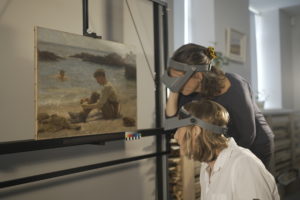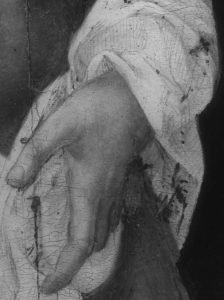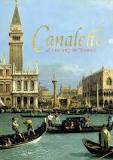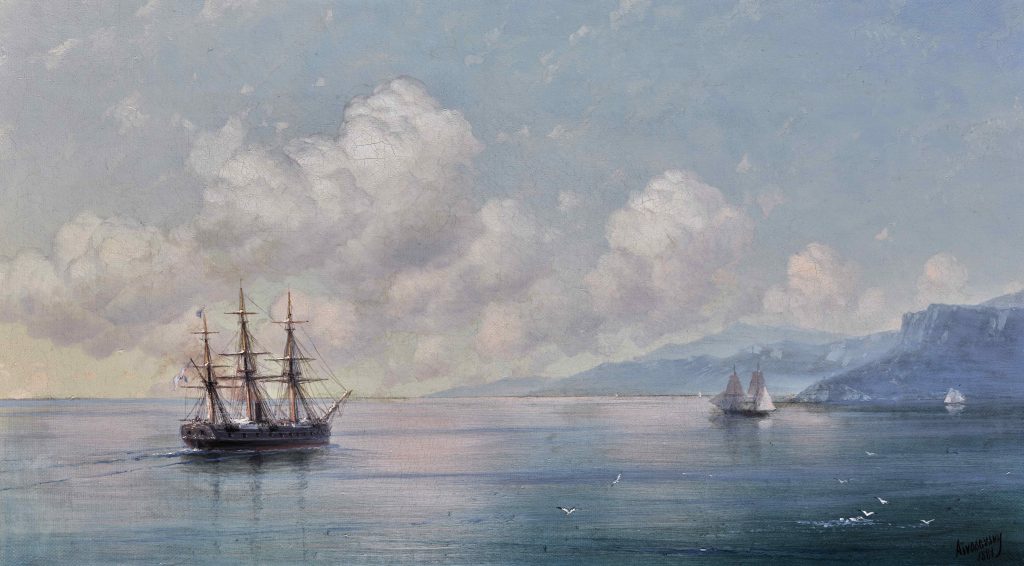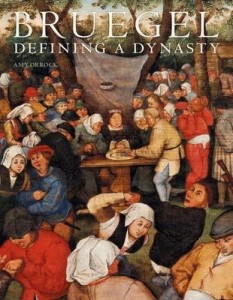TSR is excited to be a part of the latest series of Hidden Treasures of the National Trust. The episode, set to air on BBC2 at 9pm on Friday 16th May and available on iplayer, will explore the fascinating story behind a painting belonging to Lawrence of Arabia from Clouds Hill. Can infrared reflectography help to answer the questions surrounding the identity of the mysterious soldier?
Author Archives: kate
TSR’s Infrared Reflectography of the Courtauld Gallery’s Botticelli Altarpiece Helps Shed New Light on the Artist’s Workshop Practice
Infrared reflectography undertaken during Graeme Barraclough’s extensive conservation treatment of Boticelli’s The Trinity with Saints Mary Magdalene and John the Baptist (around 1491-94) revealed an earlier position for Tobias and the Angel, with the figures painted to a high level of finish. These small scale figures, like many other aspects of the painting, are rather inconsistent and their characteristic handling led Dr Scott Nethersole to attribute them to Filippino Lippi. Other features of the painting point to a rather long production history, suggesting the altarpiece may have been initiated in the 1470s, with significant involvement of the studio and revision by Botticelli, including replacing Lippi’s figures with a more prominent, larger scale Tobias and the Angel.
The painting will form part of a special exhibition at the Courtauld in 2023. To find out more about the conservation and art historical research undertaken at the Courtauld go to: The Trinity with Saints Mary Magdalen and John the Baptist – The Courtauld
Or listen to the fantastic podcast Conservation at The Courtauld: Rediscovering Sandro Botticelli’s ‘Trinity Altarpiece’ – Courtauld Cast | Podcast on Spotify where Clare Richardson describes the process of infrared reflectography.
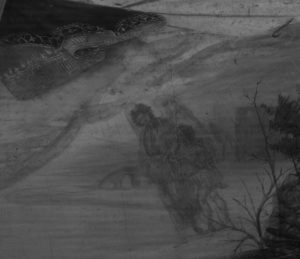
Infrared Refletogram detail of the forergound of Botticelli’s Altarpiece ‘The Trinity with Saints Mary Magdalene and John the Baptist’, The Courtauld, London (Samuel Courtauld Trust) showing the original position of the figures of Tobias and the Angel.
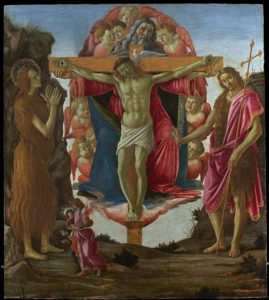
Sandro Botticelli, ‘The Trinity with Saints Mary Magdalene and John the Baptist’, Around 1491-1494, Tempera and oil(?) on panel, 192.4 by 214cm, The Courtauld, London (Samuel Courtauld Trust)
Photo © The Courtauld
after conservation treatment
Clare & Kate publish New Technical Discoveries revealing Rubens’s Artistic Process
Clare and Kate have published a digital interactive article illustrating Rubens’s complex creative process in the Journal of Historians of Netherlandish Art. The article explores the Courtauld Gallery’s Conversion of Saint Paul series, which comprise a compositional drawing, an oil sketch, and a finished painting, using improved imaging techniques to highlight Rubens’s extremely fluid approach to the development of the design. Their findings suggest a much longer gestation of these ideas than the 1610–1612 date proposed, and cast light on Rubens’s broader working practice and his ceaseless striving for aesthetic perfection, combined with a pragmatic approach to the reuse and reworking of his compositions. Complex compositional changes are revealed using X-ray, infrared, transmitted, and raking light as well as microscopic examination and can be explored using enhanced image tools and navigation. Readers can compare works of art with their technical images using the “IIIF multi-mode viewer” to better understand Rubens’s artistic exploration of ideas and aid their own research.
To read this open access research go to: https://jhna.org/articles/rubens-the-conversion-of-saint-paul/
‘Tales of the Unexpected’ – TSR’s reflectograms aid ‘Discovering Beuckelaer?’
TSR were very pleased to be able to contribute to detective work undertaken by English Heritage which allowed Alice Tate-Harte and Rachel Turnbull to re-evaluate a long-overlooked 16th century Flemish Market Scene. The condition of The Vegetable Seller had meant that it was catalogued as a copy of a 16th century work and had languished for years in a storeroom at Audley End house, Essex. Infrared examination revealed extensive underdrawing which bore striking similarities to works by Joachim Beucklaer. Read about the restoration and technical examination in the newly published book ‘Tales of the Unexpected’ in Paintings Conservation, available from Archetype publications.
Alice Tate-Harte and Rachel Turnbull ‘Discovering Beuckelaer?’ in Mary Kempski, Jo Kirby, Victoria Leanse and Kristina Mandy (Eds), ‘Tales of the Unexpected’ in Paintings Conservation, Archetype, London (2020)
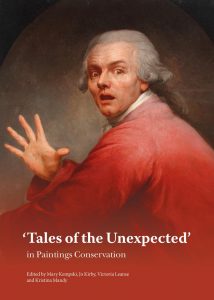
Mary Kempski, Jo Kirby, Victoria Leanse and Kristina Mandy (Eds), ‘Tales of the Unexpected’ in Paintings Conservation, Archetype, London (2020)
To explore the publication or purchase a copy go to: https://archetype.co.uk/our-titles/tales-of-the-unexpected/?id=292
We are pleased to say that this once overlooked painting has now been ‘restored to its former glory’. To read more go to: https://www.thetimes.co.uk/article/painting-cleaners-wipe-smile-off-her-face-bdf5rzrt5
TSR’s Infrared Reflectography helps to understand the development of Rubens’s Great Landscape
The Wallace Collection’s curator, Lucy Davis, has published a beautiful in-depth examination of Rubens’s iconic pendant landscapes: A View of Het Steen in the Early Morning and The Rainbow Landscape. These very personal, late works have long been recognised for their technical complexity as the artist expanded and revised the compositions multiple times. TSR were happy to be able to contribute new infrared images of The Rainbow Landscape which helped to better understand its complex development casting light on the artist’s intensions and processes.
Lucy Davis, Rubens: The Two Great Landscapes, The Wallace Collection, Philip Wilson Publishers, London (2020)
To see a preview of the book, including infrared images captured by TSR go to: https://www.amazon.co.uk/Rubens-Great-Landscapes-Lucy-Davis/dp/1781301042
Technical Examination Helps English Heritage Confirm 15th Century Painting as Botticelli
Tager Stonor Richardson were very excited to undertake infrared reflectography for English Heritage’s recent conservation treatment of the Madonna of the Pomegranate. Infrared examination revealed changes to the final composition which would not be expected in a copy and this, along with microscopic examination and x-radiography, helped to attribute the painting to Botticelli’s workshop.
Watch Rachel Turnbull, English Heritage’s Senior Collections Conservator, discuss the conservation treatment and technical investigation, with a glimpse of Colin capturing the reflectogram here.
The newly restored Madonna of the Pomegranate will be on display at Ranger’s House in Greenwich from 1st April 2019.
TSR’s Infrared Reflectography Helps to ‘Discover the Secret Techniques of an Old Master’ at Sotheby’s
TSR were pleased to contribute to the understanding of how Tosini made his monumental Mannerist masterpiece, Cleopatra, for the London Old Masters Evening Sale, 4th July 2018. The reflectogram revealed a highly complex underdrawing with dense, liquid hatching – probably done in an ink – used to ‘sculpt’ the forms.
See Chloe Stead’s blog for a discussion of how Sotheby’s use technical imaging techniques to inform their cataloguing.
TSR’s Reflectograms feature in ‘Canaletto & the Art of Venice’ Exhibition at the Queen’s Gallery
TSR were very pleased to have one of their reflectograms included in the current Royal Collection exhibition, which offers new insight into the ‘world’s finest group of paintings, drawings and prints by Venice’s most famous view-painter, Canaletto’. The exhibition runs from the 19th May to the 12th November 2017 and is accompanied by an excellent scholarly catalogue by Lucy Whitaker and Rosie Razall. The catalogue also includes infrared reflectograms taken by TSR that help shed light on the artist’s working methods and reveal the otherwise hidden techniques of his drawings.
TSR’s Infrared Reflectography Contributes to Sotheby’s Cataloguing of Russian Paintings
TSR were excited to undertake infrared reflectography on a group of Russian paintings for the 6th June 2017 sale of Russian Pictures at Sotheby’s.
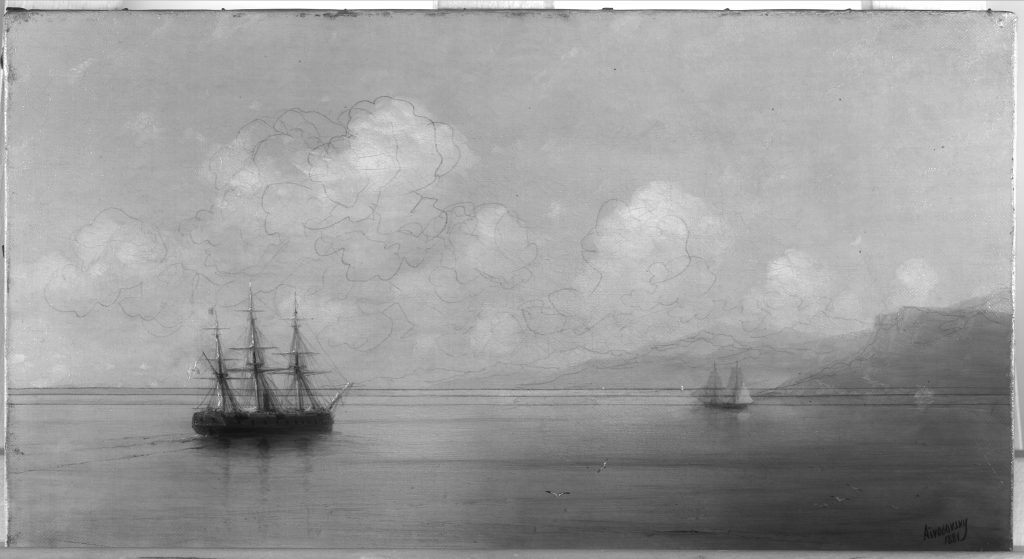
TSR Infrared Reflectogram of Ivan Aivazovsky ‘Ship off the Crimean Coast’, Image Courtesy of Sotheby’s
This group of Nineteenth Century pictures proved particularly fruitful in infrared showing distinctive underdrawing techniques as well as some surprising pentimenti; some of which are discussed in Charlotte Larkin’s blog: The Infrared Technology Revealing the Hidden Secrets of Paintings.
TSR’s Infrared Reflectography help the Holburne Museum to firmly attribute their ‘Wedding Dance in the Open Air’ to Pieter Brueghel the Younger
‘Bruegel: Defining a Dynasty’ Exhibition, 11 February – 4 June 2017
TSR were very excited to undertake infrared examination of the Holburne Museum’s ‘Wedding Dance in the Open Air’. In recent times, much study has been undertaken on paintings based on the compositions of Pieter Bruegel the Elder to try to distinguish his work from that of his sons, Pieter Brueghel the Younger and Jan Brueghel the Elder, their studios and later pastiches based on these incredibly popular motifs. The highly characteristic underdrawing revealed in the infrared reflectogram confirmed the Museum’s attribution to Pieter Brueghel the Younger. This newly discovered masterpiece adds to the Holburne Museum’s outstanding collection of Bruegelian art, which includes ‘Robbing the Bird’s Nest’ and ‘Visit to a Farmhouse’, making it the primary collection of Pieter Brueghel the Younger’s work in the UK.
A book to accompany the exhibition Bruegel: Defining a Dynasty, which includes reflectograms by TSR, is written by Dr. Amy Orrock and published by Philip Wilson, and is now available to purchase.
Links in the Press
Today Programme, Radio 4 http://www.bbc.co.uk/programmes/p04fg153
The Guardian https://www.theguardian.com/artanddesign/2016/nov/06/brueghel-family-art-show-holburne-wedding-dancers-centre-stage
The Art Newspaper http://theartnewspaper.com/news/newly-discovered-breughel-to-go-on-show-in-first-uk-exhibition-on-the-dynasty-of-painters/

